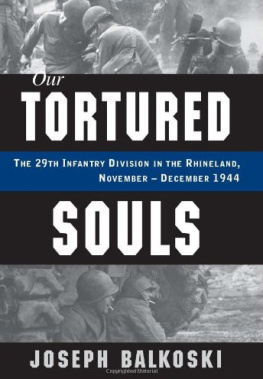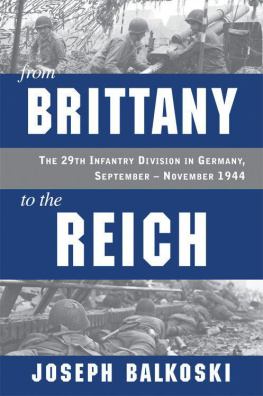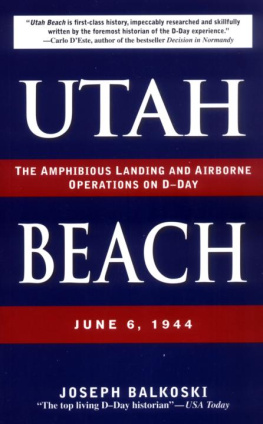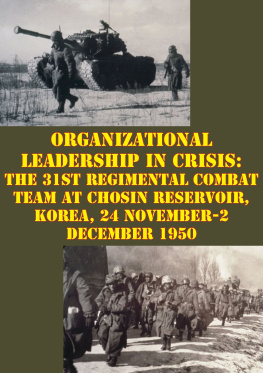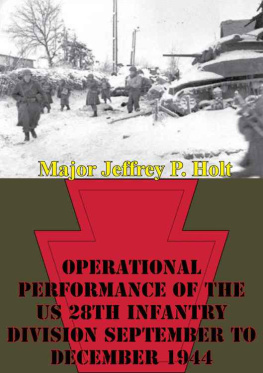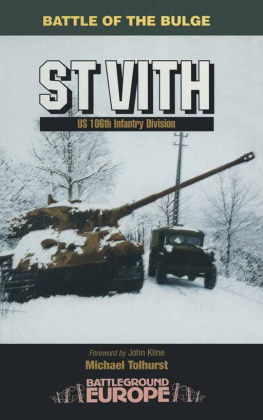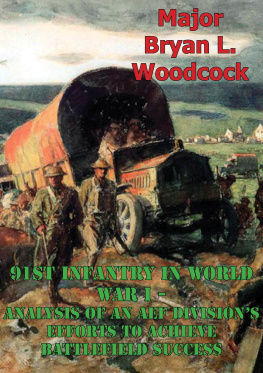OUR TORTURED SOULS

ALSO BY JOSEPH BALKOSKI
Omaha Beach
Utah Beach
History of the 29th Infantry Division in World War II
Beyond the Beachhead
From Beachhead to Brittany
From Brittany to the Reich
OUR TORTURED SOULS
The 29th Infantry Division in the Rhineland, NovemberDecember 1944
Joseph Balkoski
STACKPOLE BOOKS
Copyright 2013 by Joseph Balkoski
Published by
STACKPOLE BOOKS
5067 Ritter Road
Mechanicsburg, PA 17055
www.stackpolebooks.com
All rights reserved, including the right to reproduce this book or portions thereof in any form or by any means, electronic or mechanical, including photocopying, recording, or by any information storage and retrieval system, without permission in writing from the publisher. All inquiries should be addressed to Stackpole Books.
10 9 8 7 6 5 4 3 2 1
Library of Congress Cataloging-in-Publication Data
Balkoski, Joseph.
Our tortured souls : the 29th Infantry Division in the Rhineland, NovemberDecember 1944 / Joseph Balkoski.
pages cm
Includes bibliographical references and index.
ISBN 978-0-8117-1169-2
1. United States. Army. Infantry Division, 29th. 2. World War, 19391945Regimental historiesUnited States. 3. World War, 19391945CampaignsGermanyRhineland. I. Title.
D769.329th .B36 2013
940.54'21343dc23
2012034669
eBook ISBN: 978-0-8117-4990-9
For
Robert M. Miller
CO, Company F, 175th Infantry (5th Maryland),
29th Infantry Division
19421944
Loyal soldier, neighbor, and friend

Contents
Maps
Introduction: 29, Let's Go!
H ad the men of the 29th Infantry Division realized in November 1944 that their World War II combat history had not even reached its halfway point, they would have wondered if their illustrious outfit could endure any longer. The loss of 16,500 men in the division's first five months of combat had a decidedly enervating impact on the 29th, a unit that at full strength consisted of little more than 14,000 GIs. It had all begun on Omaha Beach, when 1,300 29ers had become casualties in an eighteen-hour period. In the nearly continuous combat that had ensued in Normandy, Brittany, and Germany, personnel within the division's twenty-seven rifle companies had turned over so many times that by autumn a D-Day veteran was an object of curiosity among the neophytes who comprised the vast majority of the units.
In From Brittany to the Reich, the previous installment of this 29th Division series, we left the Blue and Gray Division poised in western Germany to launch an all-out offensive, scheduled for November 16, 1944. At least among General Gerhardt's loyal staff in the division's war room tent, it was a moment of earnest optimism, for the U.S. Army's top brass had proclaimed that if all went well, the Americans should reach the mighty Rhine River by Christmas with the 29ers leading the way. Beyond that lay Berlinand, even better, a troopship at a German wharf crammed with happy GIs heading home to the States.
Cheerful reveries of that kind, however, were premature. By that stage of the war, in fact, it was far more natural for riflemen at the tip of the 29th Division's spear to display much more cynicism than optimism. Every battle they had fought so far in World War II had been considerably more arduous and costly than the generals had foreseen. Whatever the future would bringand this time the 29ers would have to cope with appalling weather as well as an implacable enemyeven the lowliest GI realized the quickest route home would require pummeling the enemy into extinction, the same blunt conclusion that Generals Grant and Sherman had reached in the Civil War's terminal stage. It would not be easynothing the 29th Division had done against the Germans ever wasbut sooner or later, the Jerries must crack and Gerhardt's men would thereupon surge into the heart of the Fatherland.
That day, when it finally came, would be glorious. But all 29ers participating in General Ike's Great Crusade could not fail to ponder sorrowfully the multitude of brothers-in-arms currently buried deep within the soil of France and Holland; the goal for which those men had sacrificed their lives must be fulfilled. The dead would not experience the imminent victory. The only thing left of them was memories. Those memories, however, were more than strong enough to hold the 29th Infantry Division together until the inevitable, crashing finale.
Lincoln had said it best: The living 29ers must take increased devotion to that cause for which theythese honored deadhad given the last full measure of devotion.
29TH INFANTRY DIVISION ORGANIZATION
In mid-November 1944, because of a theater-wide shortage of U.S. Army infantry replacements, the 29th Infantry Division conducted offensive operations with a complement of men far short of the 14,300 stipulated by official tables of organization. The core of the 29th Division consisted of its three infantry regiments: 115th (1st Maryland); 116th (Stonewall Brigade); and 175th (5th Maryland). All three had considerably fewer men than the prescribed figure, 3,100. According to a venerable U.S. Army custom, the word regiment is considered superfluous when designating units of regimental size, and references to the 115th Infantry, for example, always imply regiments.
A regiment was configured into three 870-man battalions, designated 1st, 2nd, and 3rd, typically commanded by a major or lieutenant colonel. Battalions in turn were broken down into companies: A, B, C, and D in the 1st; E, F, G, and H in the 2nd; I, K, L, and M in the 3rd. (By convention, no U.S. Army regiment contained a J Company.) Companies D, H, and M were heavy weapons companies, armed with six 81-millimeter mortars and eight machine guns. All other lettered companies were rifle companies. Each battalion also contained a headquarters company of 126 men.
Rifle companies were organized into three forty-one-man rifle platoons and a single thirty-five-man weapons platoon, equipped with three 60-millimeter mortars and two machine guns. In turn, each rifle platoon was broken down into three twelve-man rifle squads and a five-man platoon headquarters. Led by a staff sergeant, a rifle squad was equipped with eleven M-1 rifles and a single Browning automatic rifle.
The 29th Division also included thousands of non-infantry soldiers, among them artillerymen, engineers, cavalrymen, military policemen, signalmen, and musicians, as well as medical, ordnance, and quartermaster personnel.
29TH INFANTRY DIVISION, NOVEMBER 18, 1944
| Division Headquarters |
| Commanding General | Maj. Gen. Charles Gerhardt, Jr. |
| Assistant Division Commander | Col. Leroy Watson |
| Division Staff |
| Chief of Staff | Lt. Col. Louis Smith |
| G-1 (Personnel) | Lt. Col. Cooper Rhodes |
| G-2 (Intelligence) | Lt. Col. Paul Krznarich |
| G-3 (Operations) | Lt. Col. William Witte |
| G-4 (Supply) | Lt. Col. Louis Gosorn |
| Division Artillery |
| Commanding General | Brig. Gen. William Sands |
| Executive Officer | Col. H. Ridgely Warfield |
| 110th Field Artillery Battalion | Lt. Col. John P. Cooper |
| 111th Field Artillery Battalion |
Next page
